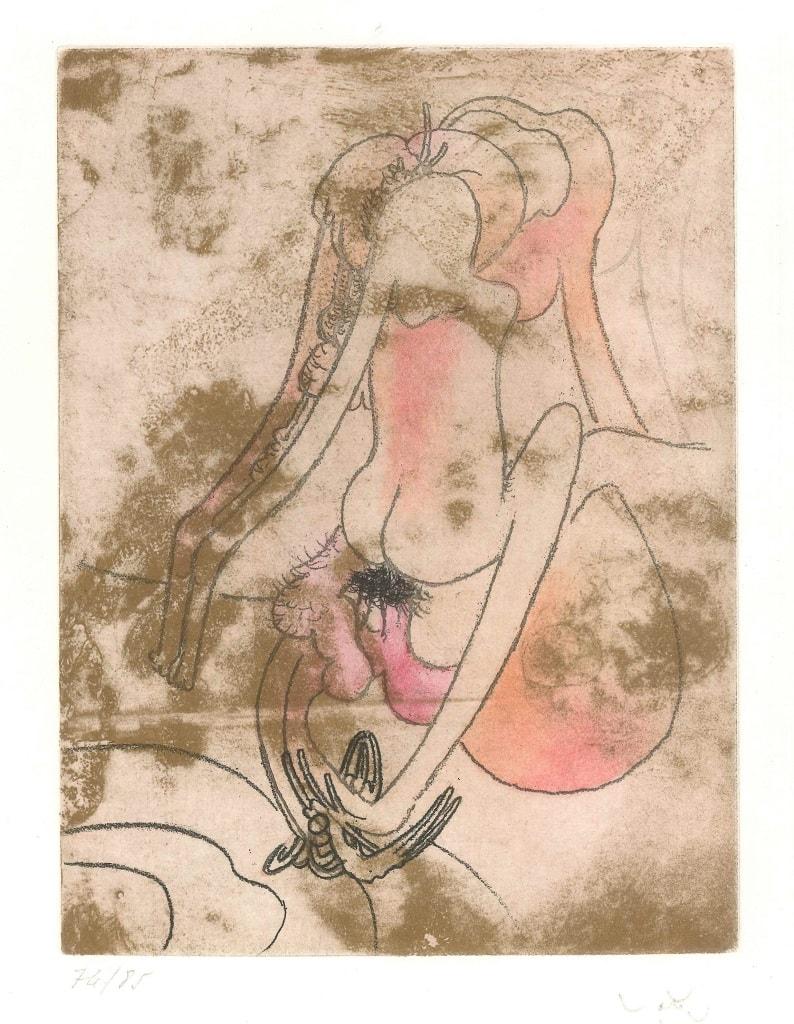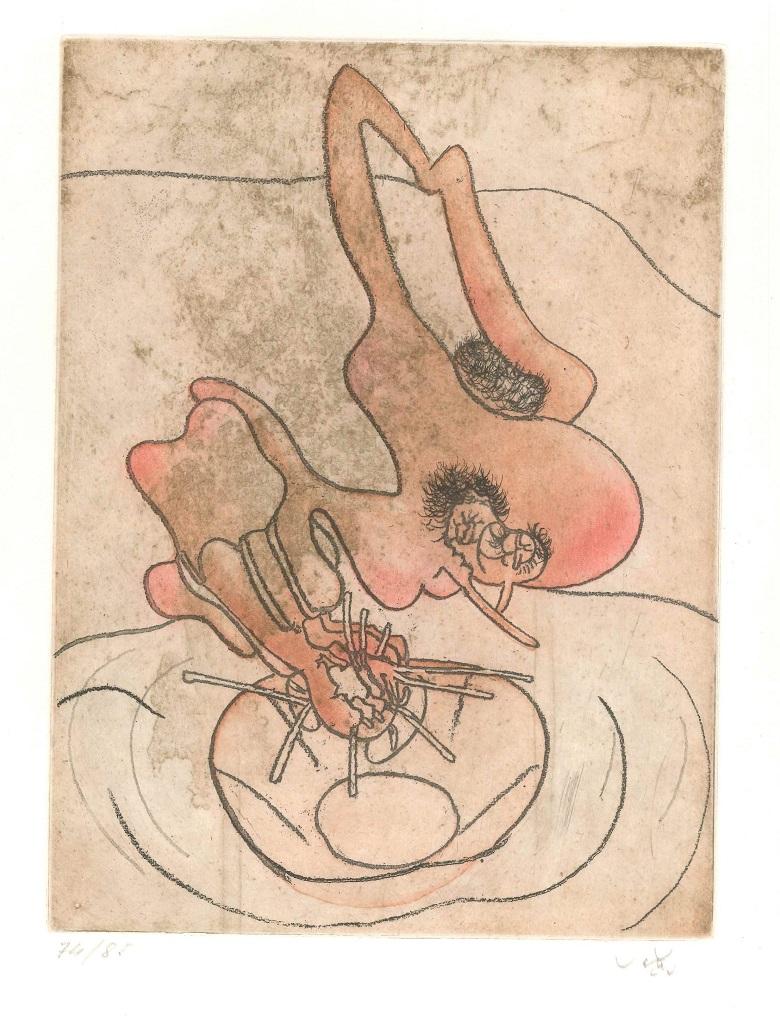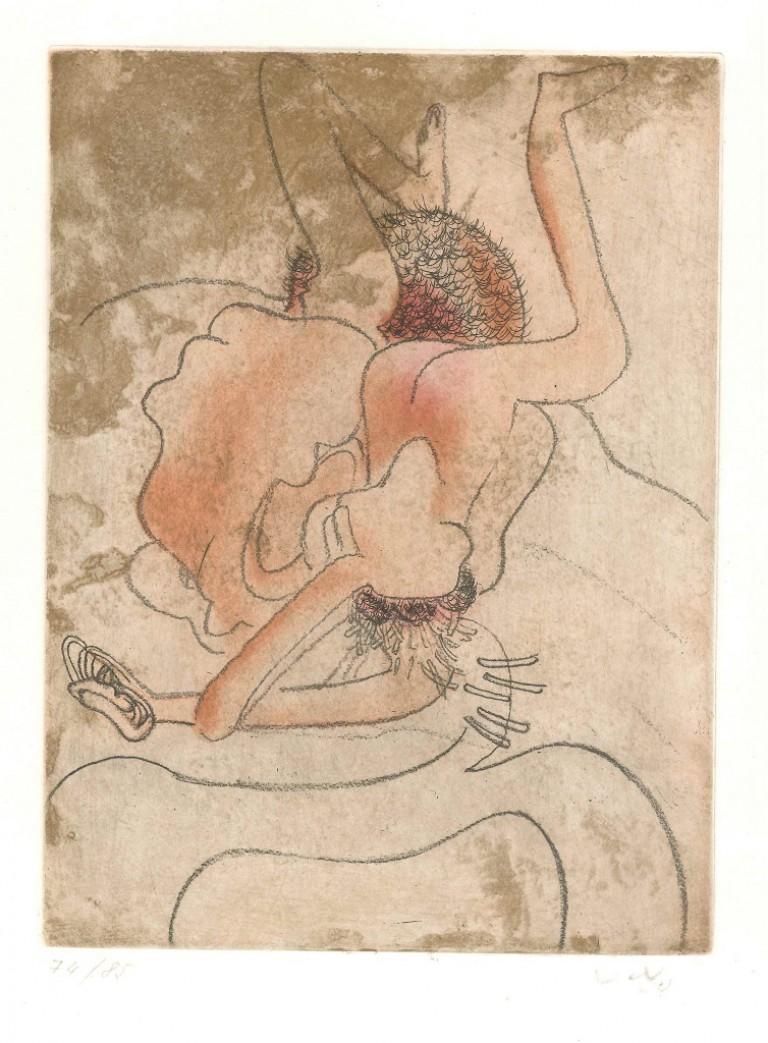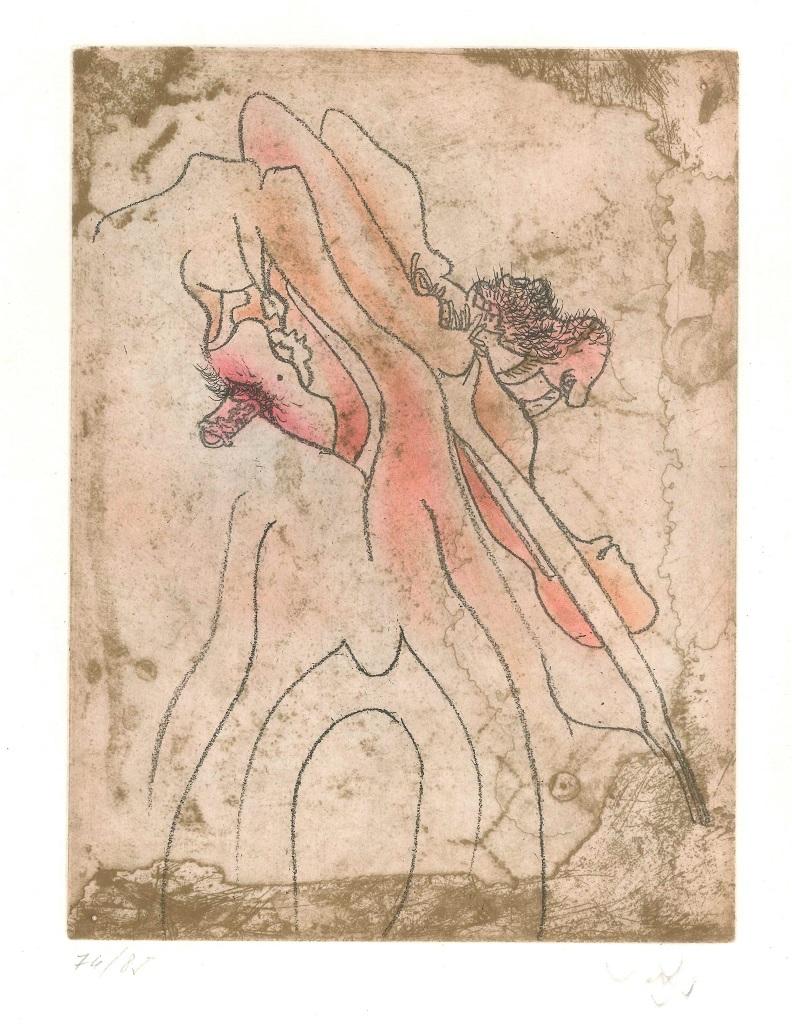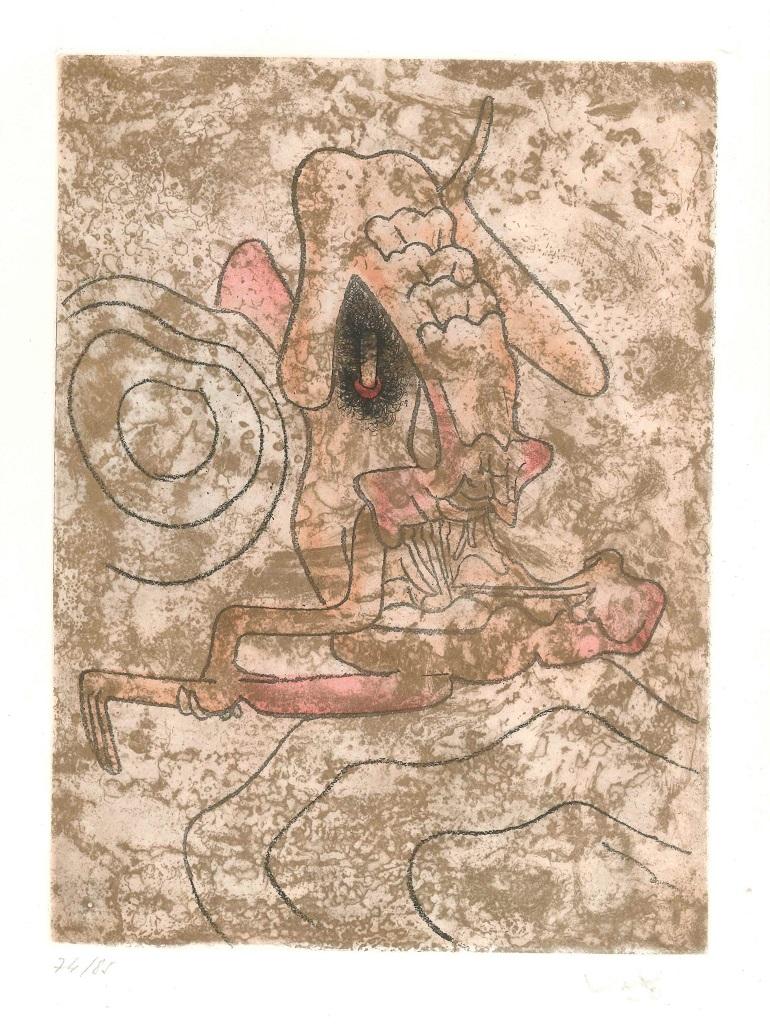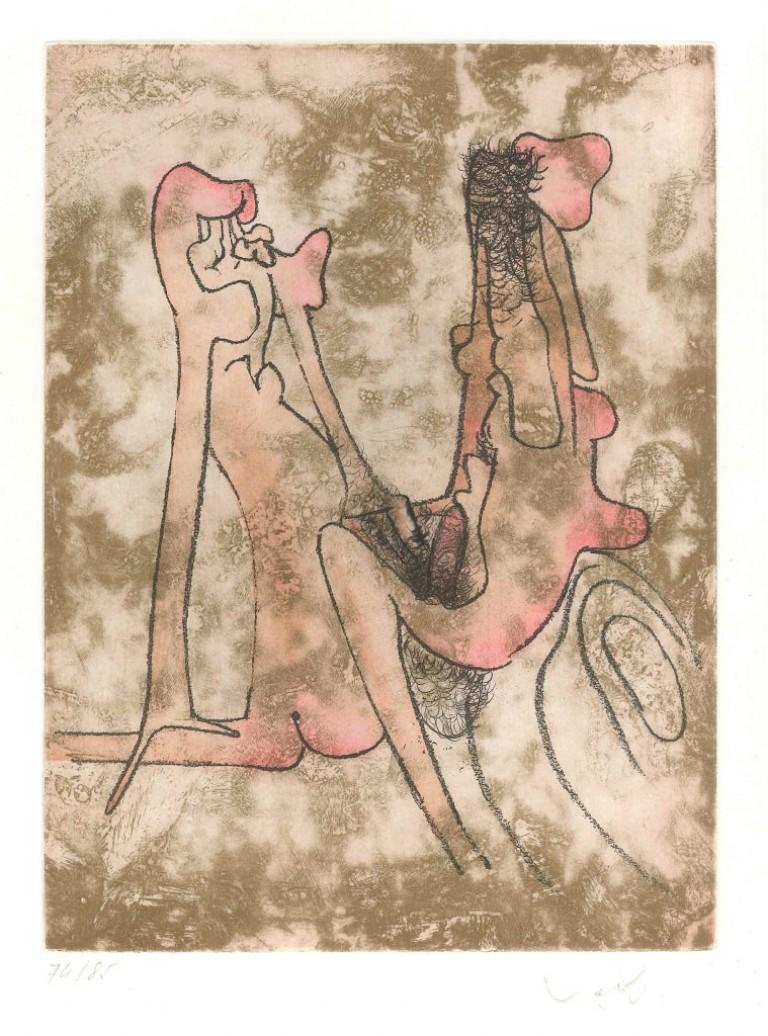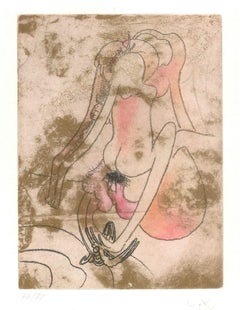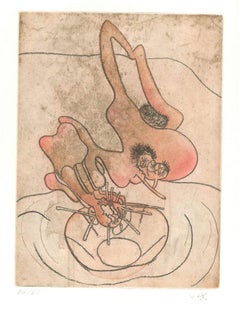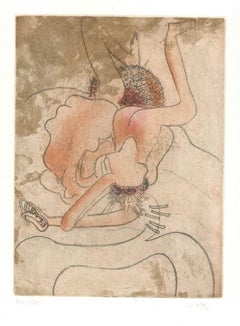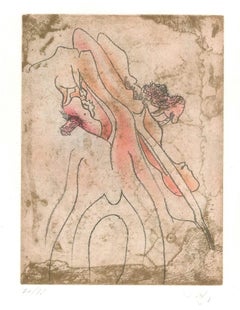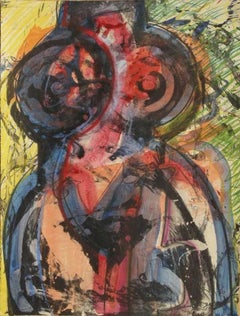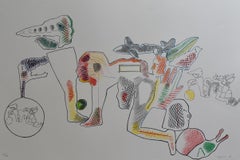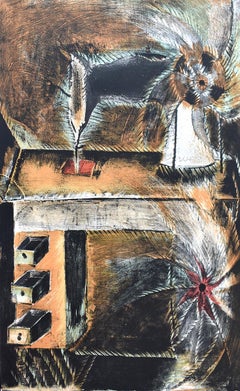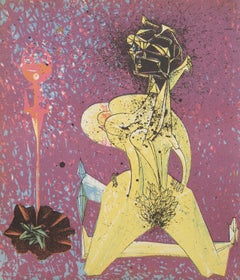Items Similar to Untitled Plate 5 from Paroles Peintes Suite - 1970s - Sebastián Matta
Want more images or videos?
Request additional images or videos from the seller
1 of 5
Sebastian MattaUntitled Plate 5 from Paroles Peintes Suite - 1970s - Sebastián Matta1971
1971
$1,246.85
£948.57
€1,050
CA$1,749.14
A$1,908.63
CHF 987.46
MX$22,832.97
NOK 12,474.05
SEK 11,712.93
DKK 7,998.47
About the Item
Untitled Plate 5 from the Paroles Peintes Suite is an etching with aquatint on Japon paper. Hand-signed in pencil on the lower right; numbered on the lower left in pencil. Edition of 85 prints.
Excellent conditions: as good as new.
This beautiful etching representing an erotic sceneis from a suite of 10 engravings, realized in 1971 by the Surrealist master Sebastián Matta. With a soft line and an extraordinary study of shapes, this plate is the perfect example of the surreal and abstract input at the service of the master of technique.
Image Dimensions: 23.5 x 17.5 cm
- Creator:
- Creation Year:1971
- Dimensions:Height: 15.16 in (38.5 cm)Width: 11.11 in (28.2 cm)Depth: 0.04 in (1 mm)
- Medium:
- Movement & Style:
- Period:
- Framing:Framing Options Available
- Condition:Insurance may be requested by customers as additional service, contact us for more information.
- Gallery Location:Roma, IT
- Reference Number:Seller: M-966871stDibs: LU65033578832
About the Seller
4.9
Platinum Seller
Premium sellers with a 4.7+ rating and 24-hour response times
1stDibs seller since 2017
7,802 sales on 1stDibs
Typical response time: 1 hour
- ShippingRetrieving quote...Shipping from: Roma, Italy
- Return Policy
More From This Seller
View AllUntitled Plate 7 from Paroles Peintes Suite - 1970s - Sebastián Matta
By Sebastian Matta
Located in Roma, IT
Untitled Plate 7 from Paroles Peintes Suite is an etching and aquatint on Japon paper.
Hand-signed and hand-numbered in pencil on the lower margin. Edition of 85 prints.
Perfect con...
Category
1970s Contemporary Abstract Prints
Materials
Etching, Aquatint
Untitled Plate 9 from Paroles Peintes Suite - 1970s - Sebastián Matta
By Sebastian Matta
Located in Roma, IT
Untitled Plate 9 from Paroles Peintes Suite is an etching and aquatint on Japon paper. Hand-signed and hand-numbered in pencil on the lower margin. Edition of 85 prints.
Perfect con...
Category
1970s Contemporary Abstract Prints
Materials
Etching, Aquatint
Untitled Plate 3 from Paroles Peintes Suite - 1970s - Sebastián Matta
By Sebastian Matta
Located in Roma, IT
Untitled Plate 3 from Paroles Peintes Suite is a limited edition print.
Etching with aquatint on Japon paper. Hand-signed in pencil on the lower right; numbered on the lower left in ...
Category
1970s Contemporary Abstract Prints
Materials
Etching, Aquatint
Untitled Plate 2 from Paroles Peintes Suite - 1970s - Sebastián Matta
By Sebastian Matta
Located in Roma, IT
Untitled Plate 2 from Paroles Peintes Suite is a wonderful limited edition print.
Etching with aquatint on Japon paper. Hand-signed in pencil on the lower right; numbered on the lowe...
Category
1970s Contemporary Abstract Prints
Materials
Etching, Aquatint
Untitled Plate 6 from Paroles Peintes Suite - 1970s - Sebastián Matta
By Sebastian Matta
Located in Roma, IT
Untitled Plate 6 from Paroles Peintes Suite is an etching with aquatint on Japon paper.
Hand-signed in pencil on the lower right; numbered on the lower left in pencil. Edition of 85 ...
Category
1970s Contemporary Abstract Prints
Materials
Etching, Aquatint
Untitled Plate 4 from Paroles Peintes Suite - 1970s - Sebastián Matta
By Sebastian Matta
Located in Roma, IT
Untitled Plate 4 from Paroles Peintes Suite is an etching with aquatint on Japon paper.
Hand-signed in pencil on the lower right; numbered on the lower left in pencil. Edition of 85 ...
Category
1970s Contemporary Abstract Prints
Materials
Etching, Aquatint
You May Also Like
Luis Miguel Valdes, ¨Homenaje a Servando XXV¨, 1986, Work on paper, 18.5x14 in
By Luis Miguel Valdes
Located in Miami, FL
"Luis Miguel Valdes (Cuba, 1949)
'Homenaje a Servando XXV', 1986
drawing, mixed media, lithograph on paper
18.6 x 14.1 in. (47 x 35.6 cm.)
ID: VAL-3G1986-25"
Category
1980s Contemporary Drawings and Watercolor Paintings
Materials
Paper, Watercolor
Untitled, from: 12th Anniversary Galeria Joan Prats 1976-88 Portfolio, 1986
By Jorge Castillo
Located in London, GB
This original lithograph in colours is hand signed in pencil by the artist “Castillo” in the lower right image. It is dated "86" [1986] next to the signature.
It is also hand numbered in pencil from the edition of 100, at the lower left image.
There were 20 artist’s proofs and 10 hors commerce [out of trade] impressions.
It was included in the portfolio “Carpeta Commemorativa 12e Aniversari” [Commemorative 12th Anniversary Portfolio], consisting of 20 lithographs and etchings by numerous artists.
The paper bears the Guarro watermark in the upper left sheet corner.
Note:
The contributing artists were: Sergi Aguilar, Frederic Amat...
Category
Late 20th Century Abstract Abstract Prints
Materials
Lithograph
Untitled, from: 12th Anniversary Galeria Joan Prats 1976-88 Portfolio
By Francisco Toledo
Located in London, GB
FRANCISCO TOLEDO 1940-2019
Juchitán de Zaragoza 1940-2019 Oaxaca (Mexican)
Title: Untitled, from: 12th Anniversary Galeria Joan Prats 1976-88 Portfolio, 1988
Technique: Original Hand Signed and Numbered Lithograph in Colours on Arches Wove Paper
Paper size: 56 x 38 cm. / 22 x 14.9 in.
Additional Information: This original lithograph in colours is hand signed in pencil by the artist “Toledo” in the centre right of the image.
It is also hand numbered in pencil from the edition of 100, next to the signature.
There were 20 artist’s proofs and 10 hors commerce [out of trade] impressions.
It was included in the portfolio “Carpeta Commemorativa 12e Aniversari” [Commemorative 12th Anniversary Portfolio], consisting of 20 lithographs and etchings by numerous artists.
The paper bears a partial Arches watermark in the upper right corner.
Note:
The contributing artists were: Sergi Aguilar, Frederic Amat...
Category
1980s Abstract Abstract Prints
Materials
Lithograph
Untitled from Le Surrealisme en 1947, Surrealist Lithograph by Jacques Herold
Located in Long Island City, NY
Jacques Herold (1910 - 1987) - Untitled from Le Surrealisme en 1947, Year: 1947, Medium: Lithograph, Edition: 950, Size: 9 x 7.75 in. (22.86 x 19.69 cm), Printer: Mourlot, Paris, Pu...
Category
1940s Surrealist Prints and Multiples
Materials
Lithograph
Set of 5 lithographs by Sebastian Matta "Los 5 destacados" , 1976
By Sebastian Matta
Located in Vicenza, VI
Roberto Sebastian Matta-Clark was a 20th-century painter, printmaker and architect. Father of renowned architect Gordon Matta-Clark, Sebastian was a major player in Surrealism and pa...
Category
1970s Abstract Figurative Prints
Materials
Lithograph
Luis Miguel Valdes, ¨Homenaje a Servando IX¨, 1986, Work on paper, 18.5x14 in
By Luis Miguel Valdes
Located in Miami, FL
"Luis Miguel Valdes (Cuba, 1949)
'Homenaje a Servando IX', 1986
drawing, mixed media, lithograph on paper
18.6 x 14.1 in. (47 x 35.6 cm.)
ID: VAL-3G1986-09"
Category
1980s Contemporary Drawings and Watercolor Paintings
Materials
Paper, Watercolor
More Ways To Browse
Brice Marden Distant Muses
Calder Bird
Calder Pyramids Signed
Calder Sunburst
Chloe Cheese
Christopher Wool My House
Cindy Sherman Deck
Cy Twombly On Sale
Dali Alice Adventure In Wonderland
Dali Ben Gurion
Dali Elijah
Dali Four Seasons
Dali Windmill Print
Damien Archangel
Damien Hirst And Dots
Damien Hirst Archangel
Damien Hirst Aspects
Damien Hirst Elements
